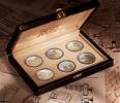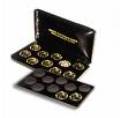
 |
 |
 |
 |
Collecting Coins Reviews
Detecting Counterfeit Coins
How to Detect Counterfeit Coins
A special machine does the stamping of coins to make them genuine. People who counterfeit coins are well trained and have the capacity to manipulate their duplication - especially those rare coins which have high value among collectors. The most plain procedure used in counterfeiting is that they pour a liquid metal into molds that will leave die marks with cracking on the counterfeit coin.
Those who are experts in determining counterfeit coins have observed that the changes seen in the coins have added, removed, or even altered the coin’s date markings. If a person thinks that he is in possession of a counterfeit collectible coin, he can compare it with another coin – one like the suspect coin – which is known be genuine and have the alike markings.
If the coin’s value is more than 5 cents, look for corrugations in the outer edges of the coin. These are very thin railings ( also know as “reeding” ) on the edges of the coins. Genuine coins have very suspect edges and the railings are even and distinct if one is very observant. Those coins that are counterfeit can be distinguished if the edges are not thin enough and the railing is uneven or missing in some areas.
Should there substitute an instance when a person perceives that he has received a counterfeit coin, he must not return the counterfeit coin to the person that handed him. He must try to delay the person – should he try to escape – or whack to keep that person in sight and follow him to his destination if plausible. It is important to remember the person’s clothes and physical appearance and if the person has any companion during the exchange: if they have a vehicle, get the car’s license plate figure and immediately call the nearest police department or the United States Secret Service for help.
Ace are many things that can be considered to determine whether the coin is counterfeit or not. There are terms that are used to describe a counterfeit coin’s characteristics and they are as follows:
1. A restrike of a coin power be considered to be genuinely authenticated. These coins are utterly dated earlier than those originally issued by the country that released them but have the twin or definite features as the primary coins.
2. Coins of a private domain in the ancient times are sometimes copied by another country. A article may think that it is forgery, but it is not because they had been legally approved in the country where they originated.
3. Forgery can be associated with the making of an unlawful profit. It would be the main objective of the counterfeiting syndicate. The check sometimes uses forgery for political propaganda, as in the Second World War when Germans produced millions of American and British banknotes with the intention of profiting from them and destabilizing their enemy’s economic situation.
4. Another known type of counterfeit coins is replica coins. Replica simply means that the original coins are copied with the same features and markings. The usual counterfeit coins have differences that are noticeable when examined by coin experts. Some coins have the word “copy” intentionally put on the sides of the coins and these replicas are used for educational purposes and museum displays.
5. A Lebanese connection is said to have a huge production of counterfeit coins. These coins were found to be used in an attempt to fool many museums, collectors, business leaders and other countries that are searching for their ancient lost coins before the discovery of this syndicate.
6. The collector intended forgery and the circulated intended forgery are types of forgeries where the coins are intended to produce tokens yet the face values are accepted, despite of their illegality and irrelevant intrusive values.
It is important to consult an brilliant to determine if the coin is counterfeit or fake. An ordinary person duty easily detect if the wrong metal was used for the counterfeiting. If the person is a collector of such items, he should be more aware of these coins. A collector needs to be more concerned with the collectible rare coins because this is position counterfeiters benefit frequently - their aim is to free lunch from the native market for valuable coins.
Share This With Your Friends |
Should You Use A Grading Service
Guide For Rare Coin Collectors
More Collecting Coins Articles
... curious collector if... - you are more interested in coin collecting than simply collecting them because you received them as gifts - you don't mind buying coins, especially if they are inexpensive - you are more interested in browsing coin shops than a casual collector - you spend time surfing the net ...
... visit to see if they have the coins available that you thirst to add to your collection. Most of these coin shops are located in the larger town or cities. Better yet, use your regular phone book and start walking those fingers through the pages to find out where the nearest coin shop ( s ) is located... ...
... enabling him to manage his budget easily. 6. It is important to have a separate holder for his ancient coin collection or his distinctive collections. Separate holders will help the collector organize and preserve his coins. Ancient coins are generally more expensive than other collectible coins so it ...
Pros And Cons Of Buying At Auction
... buyers the option to acquire these types of coins at subordinate prices. Online auction sales usually take 3 to 4 months to process depending on how fast bidders can decide on their bids or when the bidding process closes. No matter how popular auction sales have become to countless collectors, it is ...

|
| Copyright © 2006-2012 Internet Marketing Tools, All Rights Reserved |